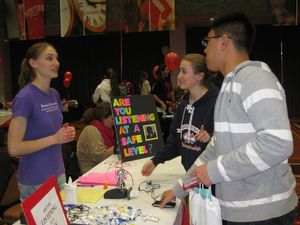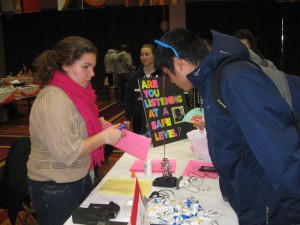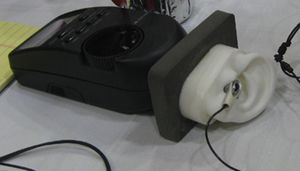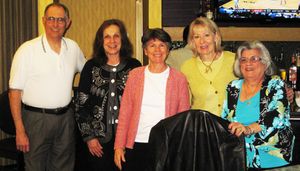May, 2013 In the aftermath of the marathon bombing there is so much to think about and so many to care for. Maybe later I will write about the effects on hearing, but in the meantime here is an ASHASphere blog that says it very well.
December, 2012 Here are links to blog posts I wrote this past year for the ASHAsphere, the blog site of the American Speech, Language and Hearing Association:
Why do we love loudness? (April 2012)
Crickets: Beautiful sound or terrible noise? (October, 2012)
May, 2012 NOTHING SMALLER THAN YOUR ELBOW
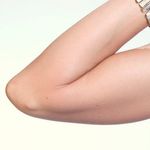 You may have heard the aphorism: “never put anything smaller than your elbow in your ear.” But people often do risky things with regard to their hearing, including putting things in their ears. And it’s not just children! This true story happened a few days ago to an erudite BU colleague.
You may have heard the aphorism: “never put anything smaller than your elbow in your ear.” But people often do risky things with regard to their hearing, including putting things in their ears. And it’s not just children! This true story happened a few days ago to an erudite BU colleague.
The ear canal is about 1 inch long. It is lined with skin and makes a few sharp twists before arriving at the ear drum (or tympanic membrane). If you stick your finger in your ear (carefully!) you may think you’ve touched your eardrum, but most likely it is just the end of the first bend.
The eardrum is a delicate structure like nothing else in the human body–a tiny, smooth membrane stretched tight across an open space. It can be punctured easily and the result is terrifically painful and horrifyingly bloody. A ruptured eardrum can result in a permanent reduction in hearing.
Just a few days ago, one of my colleagues decided to self-administer a “cure” for itchy, dry skin. He put a little Vaseline on a Q-tip and carefully swabbed the inside of his ear. Uh-oh! After reading about that delicate membrane called the eardrum, aren’t you afraid to read what happened next? Every audiologist can tell you horror stories about people sticking Q-tips in their ears and winding up with a punctured eardrum. Q-tips are dangerous, I tell you! They do not belong inside your ear.
Luckily, in this particular case the result was less horrible, but nevertheless it was quite traumatic to the individual for a day or two. Here is what happened: the Vaseline combined with the dry skin and morphed into a slimy, viscous blob that filled up the esteemed colleague’s ear canal, making a perfect seal. Now the unfortunate fellow experienced a unilateral hearing loss that affected his ability to communicate, and even to think straight. He was distracted and disoriented. So, being away from home on a business trip, he took himself to the emergency room where they flushed out the offending material with water.
Although this particular story has a happy ending, heed its warning: nothing smaller than your elbow in your ears! In fact, it’s better not to put anything at all in your ears.
APRIL, 2012. Recently I worked with students in the Speech, Language and Hearing Sciences program to sponsor a table at the annual Be a Healthy U Wellness Fair. We dispensed earplugs and advice on safe listening, especially focusing on personal listening devices.
Hearing loss prevention is tricky and interesting because:
- Loudness is different for everyone: what’s loud to me may seem soft to you.
- Even for the same person, something that seems loud at one time might be OK at another time. For example: have you ever noticed that you crank the volume on your listening device when you are in a loud place…like running on a noisy street, or riding the T? Then later when you are in a quiet place and you turn it on, it seems way too loud?
- The “permissible limits” for noise exposure are based on data from factory workers who spend their lives working around loud machinery. Listening to music through headphones is a relatively new phenomenon in society. Measuring the effect on hearing requires some new calculations.
- A lot of people really LIKE listening to loud music! See my blog post dated March, 2012 for more about this.
In other words, it’s not enough if we just tell people to be careful. People need and want specific information about their own listening habits, so that is what we provide at our table.
I have a rubbery ear attached to a sound level meter, so we can measure the outputs of personal listening devices. We ask participants to set their device to a song at a level they would typically listen to. Then the students watch the sound level meter for a minute or so and record the range on a handout page, that also lists the permissible limits published by NIOSH.
This way of measuring listening device outputs is imprecise, but it gives an idea of whether someone is in great danger with their listening habits. The idea is similar to the Jolene mannequin. (BTW, Jolene’s creator—Genna–is a BU alumna!)
So join us next year at the Wellness Fair. In the meantime, turn down that volume!
NOTE (from our Wellness Fair handout): A muffled sensation, feeling of pain, or ringing sound in your ears after exposure to loud noise indicates you have done some damage to your hearing mechanism. This may seem to recover after a period of time, but repeated exposures can cause permanent hearing loss and tinnitus (ringing/buzzing in the ears). If you are concerned about your hearing, ask your physician to refer you to an audiologist for an evaluation.
March, 2012. Why do we humans enjoy doing things that are potentially harmful? Some people are crazy about dangerous activities like skydiving, extreme skiing and jumping off high cliffs wearing wingsuits. In comparison, listening to loud music seems tame!
It seems that humans have always found ways to make loud music. An early type of drum consisted of a pit dug in the ground, covered with heavy bark; dancing on the top of the pit produced a hollow, resonant sound. Stone Age people also blew into hollowed-out animal horns to produce shrill, piercing tones. And my favorite example is the bull-roarer–a thin piece of bone attached to a leather thong, which makes a roaring sound, audible for miles when whirled in the air. Such early instruments are thought to have been used mainly in warfare and for religious rites: to terrify and control, or to create a sense of wonder and mystery.
During the 19th century, people began to use principles of electromagnetism and novel ways to transform one type of energy to another. These discoveries opened the door to new and louder musical sounds. Since the advent of amplified music, there has been an increased demand for louder and louder instruments. The sound pressure at concerts today often reaches levels that can damage fans’ hearing within minutes. But people enjoy it and come back for more. I have collected survey data and anecdotal comments from people who enjoy loud music since 1995. Common themes come up:
- “Loud music allows me to completely ignore the outside world”
- “When you hear something that just grabs you, you want the volume cranked up so that you can feel it throughout your whole body, and let it pour into your soul”
- “Listening to loud music helps me to relieve stress.”
But the hearing loss and tinnitus that can result from too much loud music can be truly devastating, so we need to reach for the earplugs or turn it down, to protect the hearing that allows us to enjoy the music in the first place.
March, 2011. I am a member of the coordinating committee of the Special Interest Group on Public Health Issues related to Hearing and Balance, of the American Speech-Language Hearing Association (ASHA).
(L to R) John Ribera (editor), Ingrid Blood (co-coordinator), Ann Dix, Mary McDaniel, and Roberta Aungst (Coordinator) in Rockville MD, March, 2011.

